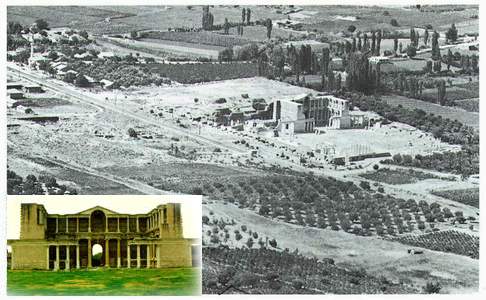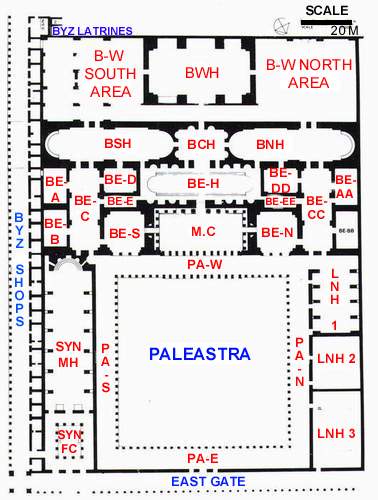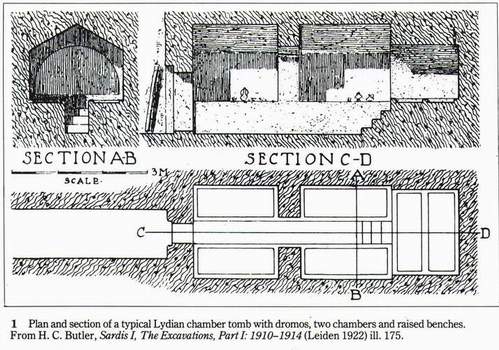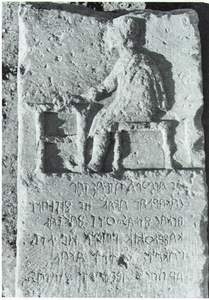The
Bath-Gymnasium Complex and the Marble Court
 |
The impressive ruins of the
bath-gymnasium complex in Sardis are easily visible immediarel north of the Izmir-Ankara
highway, some 150-200 meters from the yol-kahve bus stop. With a total area of
nearly 51/2 acres, the complex is undoubtedly the most prominent public structure
of Sardis, occupying a central position in the busy downtown area of the Roman city. The
entire southern frontage of the building is taken up by a row of shops and opens onto a
wide, colonnaded Marble Avenue.
The planning of the complex conforms to the "Imperial type
composed of a series of rooms and halls arranged symmetrically around a major axis and
terminating in a single, large caldarium. |
It displays the
characteristic features of the Roman baths in Asia Minor in which the Hellenistic
gymnasium with its colonnaded palaestra and the Roman bath with its vaulted halls
converged to produce a new type with elements common to both. In inscriptions, these
buildings are referred to as gymnasia or as baths (balnea) quite interchangably.
The closest parallel to the planning of the Sardis complex is the Vedius bath-gymnasium in
Ephesus; other comparable bath-gymnasia can be seen in Miletus, Aphrodisias and
Hierapolis.
The eastern half of the bath-gymnasium in Sardis is occupied by
a square courtyard, the palaestra, for exerciser the vaulted halls of the western half are
intended for bathing. The halls south of the palaestra were given over to the Jewish
community of the city during the late 3rd century A.D. and became a monumental synagogue.
The main entrance to the complex is from the east side of the palaestra, through a triple
gate, on the main east-west axis of the building; at the west end is Marble Court, a
rectangular space displaying a sumptuous arrangement of columnar aediculae in two stories
and dedicated to the Imperial Cult. On the entablature of the first story is a dedicatory
inscription (in red) mentioning the names of Emperors Caracalla and Geta (his name is
erased) and their mother Julia Domna, A.D. 211. On the podium, a 5th century Byzantine
inscription in verse and prose (in yellow) expresses admiration for the renewed decoration
of the building donated by a civic leader.
Since
exercise and games usually preceded hot bathing, the visitors entered into the complex by
way of the palaestra. After undressing (probably in BE-A, BE-AA, BE-B, BE-BB) and
participating in a light form of exercise, they hurried inside upon the ringing of the
tintinnabulum, which announced the opening of the hot baths. Two identical paths through
BE-N and BE-S into the group of rooms north and south of the Marble Court brought them to
the great apsidal halls BNH and BSH (the base of a Statue of Lucius Verus, ca. A.D. 161,
displayed on the apse podium), probably intended as a grand concourse of social and
ceremonial character. Next, the bathers moved into the heated western section (largely
unexcavated); passing through a series of rooms increasing in temperature from tepid to
warm, they arrived in the caldarium (BWH), which is the main bathing hail with heated
pools. From the caldarium, the bathers moved back into the eastern section into the
central hall, BCH (domed?) and finally into the large oblong hall BE-H identified as the
cold bathing hall, the frigidarium, because of the huge swimming pool occupying the floor
and private basins and pools inside the niches of the walls. After the cold bath and swim,
a final massage complete with anointment and perfume was enjoyed by many as a rejuvenating
termination of the bathing procedure; Sardians were now ready to leave the baths and hurry
to dinner.
The Marble Court (Imperial Hall-Kaise caal) deserves
emphasis not only because of the unusual visual wealth of its rntilti-storied facades, but
also the symbolic meaning of this architecture. Similar space in Roman baths and gymnasia
in Asia Minor have been associated with the observance of the Imperial cult. |
 |
The rich and varied columnar
arrangement, the imposing pedimented group of the center, the continuous podia for the
display of statuary and the polychromatic effects of marble may all allude to kingly and
palatial subjects. The setting is also closely related to the stage decoration (scaenaefrons)
of the Roman theater and suggests a link with Dionysus and the Dionysiac nature of the
emperors. The prominence of the Dionysiac theme in the decorative program of the Marble
Court-particularly in the capitals of the screen colonnade-may not have been accidental.
The Marble Court was reconstructed (1964-1973) largely to
its original A.D. 211 stage although some of the features of the later alterations were
retained. During some of these, the north and south apses of the Court were closed off by
a wall (but later cut open with doors) and the central, west apse (for the cult image?)
framed by the gigantic spirally-fluted columns, converted into a passage leading into the
frigidarium; this may have happened sometime in the 4th century when the Imperial cult was
banned or suppressed.
The reconstruction incorporates some 60-65% of the original
architectural ornament. Originally, the rubble and brick walls against which the columns
stand, were entirely covered in marble veneer. The aediculae, as seen today, are supported
by a modern reinforced concrete frame. embedded into the thickness of the massive rubble
walls; the columns carry no loads except their own weight. |
The
Necropolis
The main burial ground
for ancient Sardis was located in the hills and cliffs on both sides of the Pactolus
stream. Several types of tombs have been found in this region. These range in
architectural sophistication from simple, stone-lined cists dug into the ground to
well-built limestone chambers covered by mounds of earth, or tumuli.
| Of exceptional design is
the stepped "Pyramid Tomb located in the northwest foothills of the Acropolis. The
most common type of tomb is the chamber tomb carved into the hills' easily-worked, sandy
conglomerate. The typical Lydian chamber tomb had an entrance flanked by one or two stone
markers (stelaz), a short corridor (dromos), and one or two chambers,
usually with raised benches against the walls. The earliest of these tombs that can be
dated were made in the 6th century B.C. The necropolis continued to be used through
Persian, Hellenistic and Roman times.Before the Roman period, inhumation was the usual
practice. Bodies were placed directly into cists or in sarcophagi of clay or stone which
were then buried. |
 |
In
the chamber tombs, bodies were sometimes laid out on the benches, sometimes placed in
sarcophagi set either on the benches or into the chamber, floors. In tumulus chambers,
bodies were often laid out on stone benches. Funeral offerings included pottery and metal
vases and utensils associated with eating, drinking and personal adornment, lamps,
figurines and jewelry.
 |
More
than 1,000 chamber tombs were excavated between 1910 and 1914 by the American Society for
the Excavation of Sardis, directed by Howard Crosby Butler of Princeton University. Most
of these had been plundered in the remote or recent past. Erosion has obliterated many of
these tombs, but the visitor can still appreciate their distribution and concentration.
Directly opposite the Artemis Temple to the west, for example, the broad sloping face of a
low ridge shows many shallow depressions, all of which are tomb cavities. A readily
accessible group of five chamber tombs can be visited by following the modern road along
the west bank of the Pactolus stream to a point approximately 3 km. south of the Artemis
Temple. Just before you come to a tributary of the Pactolus and a small Turkish cemetery,
you will see the tomb doorways in a low cliff to the right, not far from the road.
Less conspicuous today are the tumuli. A few can be
spotted in the vicinity of the chamber tombs, and many, hidden by trees and shrubs,
lie on the skirt of Mt. Tmolus. These tumuli are relatively small compared to those of the
Lydian "royal cemetery at Bin Tepe, 5 krh. north of Sardis. The latter can be seen
from the Izmir-Ankara highway and make an impressive sight, especially in the early
morning and late afternoon when the mounds are highlighted by the sun and cast deep
shadows. |
 |
The photo of
stele from Sardis, now in the Manisa Museum, mv. No. 1. Dated to 520-500 B.C. The
inscription in Lydian identifies the owner of the stele and warns against damage or
defacement:
"This is the stele of Atrastas/ son of Sakardas. And thus whoeven destroys or
by misdeed (damages) I he shall pay. (And him?) and whateven/ possession (he may
have?) thus/ to Artemis of Ephesos I vow |
|

